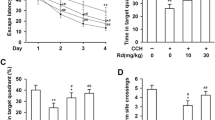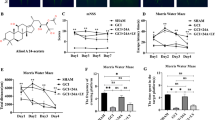Abstract
The present study screened the effect of Myricitrin on cognitive deficits post-cerebral ischemic stroke and the involved mechanism. The rats were submitted to middle cerebral artery occlusion (MCAO) and were treated with sodium butyrate or Myricitrin (15 and 30 mg/kg) for 28 days. The spatial memory was studied by Morris water maze (MWM). After 4 weeks, the rats were euthanized and hippocampus region was utilized for neurochemical and biochemical changes. The extent of histone acetylation was studied by ELISA. Protein levels were analyzed by Western blot analysis. The mRNA levels were analyzed by polymerase chain reaction (PCR). In silico bioinformatics docking studies were done for target confirmation of Myricitrin. The treatment of Myricitrin showed improved memory in MWM compared to rats treated with vehicle, and the effects of Myricitrin were similar to sodium butyrate-treated rats. At a dose of 30 mg/kg Myricitrin, the histone deacetylase content was decreased, the expression levels of BDNF were increased, the levels of acetylated H3 and H4 along with Syn-I in the hippocampus region were over-expressed compared to control vehicle-treated rats. However, at low dose, i.e., 15 mg/kg Myricitrin failed to show alterations in biochemical as well as neurochemical markers. Docking studies suggested the BDNF and Sun-I as potential target proteins of Myricitrin. The cognitive ameliorating effect of Myricitrin post-cerebral ischemia stroke can be attributed to increased expression of BDNF and Syn-I and modulation of histone acetylation.




Similar content being viewed by others
References
Cumming TB, Marshall RS, Lazar RM (2013) Stroke, cognitive deficits, and rehabilitation: Still an incomplete picture. Int J Stroke 8(1):38–45
Fischer A, Sananbenesi F, Mungenast A, Tsai LH (2010) Targeting the correct HDAC(s) to treat cognitive disorders. Trends PharmacolSci 31(12):605–617
Peixoto L, Abel T (2013) The role of histone acetylation in memory formation and cognitive impairments. Neuropsychopharmacology 38(1):62–76
Lubin FD, Sweatt JD (2007) TheIkappaB kinase regulates chromatin structure during reconsolidation of conditioned fear memories. Neuron 55(6):942–957
Zhang ZH, Wu LN, Song JG, Li WQ (2012) Correlations between cognitive impairment and brain?derivedneurotrophic factor expression in the hippocampus of post-stroke depression rats. Mol Med Rep 6(4):889–893
Chwang WB, Arthur JS, Schumacher A, Sweatt JD (2007) The nuclear kinase mitogen- and stress-activated protein kinase 1 regulates hippocampal chromatin remodeling in memory formation. J Neurosci 27(46):12732–12742
Chen DY, Bambah-Mukku D, Pollonini G (2012) Glucocorticoid receptors recruit the CaMKIIalpha-BDNF-CREB pathways to mediate memory consolidation. Nat Neurosci 75:1707–1714
Pereira M, Siba IP, Chioca LR, Correia D, Vital MABF, Pizzolatti MG, Santos ARS, Andreatini R (2011) Myricitrin, a nitric oxide and protein kinase C inhibitor, exerts antipsychotic-like effects in animal models. ProgNeuro-PsychopharmacolBiol Psychiatry 35(7):1636–1644
Fernandez SP, Nguyen M, Yow TT, Chu C, Johnston GAR, Hanrahan JR (2009) The flavonoid glycosides, myricitriin, gossypin and narigin exert anxiolytic action in mice. Neurochem Res 34:1867–1875
Meotti FC, Luiz AP, Pizzolatti MG, Kassuya CA, Calixto JB, Santos ARS (2006) Analysis of the antinociceptive effect of the flavonoid myricitrin: evidence for a role of the L-arginine-nitric oxide and protein kinase C pathways. J PharmacolExpTher 316:789–796
Zhang B, Shen Q, Chen Y, Pan R, Kuang S, Liu G, Sun G, Sun X (2017) Myricitrin alleviates oxidative stress-induced inflammation and apoptosis and protects mice against diabetic cardiomyopathy. Sci Rep 7:44239
Keikhaei F, Mirshekar MA, Shahraki MR, Dashipour A (2020) Antiepileptogenic effect of myricitrin on spatial memory and learning in a kainate-induced model of temporal lobe epilepsy. Learn Motiv 69:101610
Longa EZ, Weinstein PR, Carlson S, Cummins R (1989) Reversible middle cerebral artery occlusion without craniectomy in rats. Stroke 20(1):84–91
Foster TC, Kumar A (2007) Susceptibility to induction of long-term depression is associated with impaired memory in aged Fischer 344 rats. Neurobiol Learn Mem 87(4):522–535
Bhullar KS, Rupasinghe HP (2013) Polyphenols: Multipotent therapeutic agents in neurodegenerative diseases. Oxid Med Cell Longev 2013:891748
Pereira M, Siba IP, Chioca LR, Correia D, Vital M, Pizzolatti MG, Santos A, Andreatini R (2011) Myricitrin, a nitric oxide and protein kinase C inhibitor, exerts antipsychotic-like effects in animal models. ProgNeuropsychopharmacolBiol Psychiatry 35:1636–1644
Morris MJ, Mahgoub M, Na ES (2013) Loss of histone deacetylase 2 improves working memory and accelerates extinction learning. J Neurosci 33(15):6401–6411
Villain H, Florian C, Roullet P (2016) HDAC inhibition promotes both initial consolidation and reconsolidation of spatial memory in mice. Sci Rep 6:27015
Kim HJ, Chuang DM (2014) HDAC inhibitors mitigate ischemia-induced oligodendrocyte damage: potential roles of oligodendrogenesis, VEGF, and anti-inflammation. Am J Transl Res 6(3):206–223
Haettig J, Stefanko DP, Multani ML (2011) HDAC inhibition modulates hippocampus-dependent long-term memory for object location in a CBP-dependent manner. Learn Mem 18(2):71–79
Fass DM, Butler JE, Goodman RH (2003) Deacetylase activity is required for cAMP activation of a subset of CREB target genes. J BiolChem 278(44):43014–43019
Johnson ME, Zhou XF, Bobrovskaya L (2019) The effects of rotenone on TH, BDNF and BDNF-related proteins in the brain and periphery: Relevance to early Parkinson's disease. J ChemNeuroanat 97:23–32
Gómez-Pinilla F, So V, Kesslak JP (2001) Spatial learning induces neurotrophin receptor and synapsin I in the hippocampus. Brain Res 904(1):13–19
Pagnussat AS, Simao F, Anastacio JR (2012) Effects of skilled and unskilled training on functional recovery and brain plasticity after focal ischemia in adult rats. Brain Res 1486:53–61
Liu M, Liu S, Peterson SL, Miyake M, Liu KJ (2002) On the application of 4-hydroxybenzoic acid as a trapping agent to study hydroxyl radical generation during cerebral ischemia and reperfusion. Mol Cell Biochem 234:379–385
Acknowledgements
The authors are thankful to Basic Medical School of Jining Medical University China and also to the funding agencies.
Funding
This study was supported by The National Natural Science Foundation of China (No. 81703490), NSFC cultivation project of Jining Medical University (No. JYP2018KJ06), and The Support Foundation of Jining Medical College (No. JY2017KJ018).
Author information
Authors and Affiliations
Corresponding author
Ethics declarations
Conflict of interest
The authors declare that they have no conflicts of interest.
Additional information
Publisher's Note
Springer Nature remains neutral with regard to jurisdictional claims in published maps and institutional affiliations.
Rights and permissions
About this article
Cite this article
Gao, Y., Ya, B., Li, X. et al. Myricitrin ameliorates cognitive deficits in MCAO cerebral stroke rats via histone acetylation-induced alterations of brain-derived neurotrophic factor. Mol Cell Biochem 476, 609–617 (2021). https://doi.org/10.1007/s11010-020-03930-4
Received:
Accepted:
Published:
Issue Date:
DOI: https://doi.org/10.1007/s11010-020-03930-4




